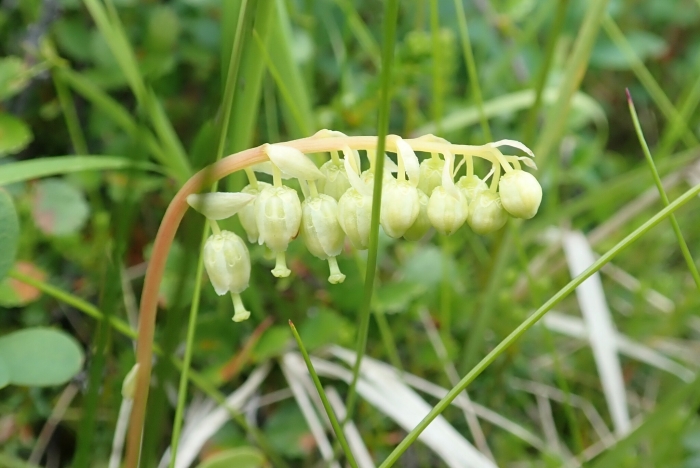Sidebells Wintergreen
(Orthilia secunda)
Sidebells Wintergreen (Orthilia secunda)
/
/

© Benoit NABHOLZ
CC BY-SA 4.0
Image By:
© Benoit NABHOLZ
Recorded By:
Copyright:
CC BY-SA 4.0
Copyright Notice:
Photo by: © Benoit NABHOLZ | License Type: CC BY-SA 4.0 | License URL: http://creativecommons.org/licenses/by-sa/4.0/ | Uploader: benoitnabholz | Publisher: iNaturalist |
























Estimated Native Range
Summary
Orthilia secunda, commonly known as Sidebells Wintergreen or One-sided Wintergreen, is a perennial herb that is mixotrophic, meaning it can obtain energy both through photosynthesis and from symbiotic fungi in the soil. It is native to the cool temperate and subarctic regions of the Northern Hemisphere, including North America, Europe, and Asia, where it typically grows in the understory of moist, shady coniferous and mixed forests. This plant is often found in acidic soils rich in organic matter, such as those covered with decaying leaf litter.
Sidebells Wintergreen is characterized by its slender, unbranched stems reaching up to 30 cm tall, with a distinctive arrangement of small, greenish-white, bell-shaped flowers that droop from one side of the stem, blooming from late spring to early summer. The leaves are evergreen, broad, and leathery, providing year-round ground cover. In cultivation, it is valued for its low maintenance, shade tolerance, and subtle beauty, making it suitable for woodland gardens and naturalized areas. It requires consistently moist soil, prefers partial to full shade, and is generally free from serious pests and diseases. However, it is slow-growing and may be outcompeted by more aggressive plants if not managed properly. Sidebells Wintergreen is not commonly used in mainstream horticulture but is of interest for its medicinal properties, as it has been traditionally used by indigenous peoples for various ailments.CC BY-SA 4.0
Sidebells Wintergreen is characterized by its slender, unbranched stems reaching up to 30 cm tall, with a distinctive arrangement of small, greenish-white, bell-shaped flowers that droop from one side of the stem, blooming from late spring to early summer. The leaves are evergreen, broad, and leathery, providing year-round ground cover. In cultivation, it is valued for its low maintenance, shade tolerance, and subtle beauty, making it suitable for woodland gardens and naturalized areas. It requires consistently moist soil, prefers partial to full shade, and is generally free from serious pests and diseases. However, it is slow-growing and may be outcompeted by more aggressive plants if not managed properly. Sidebells Wintergreen is not commonly used in mainstream horticulture but is of interest for its medicinal properties, as it has been traditionally used by indigenous peoples for various ailments.CC BY-SA 4.0
Plant Description
- Plant Type: Shrub, Herb
- Height: 0.25-0.5 feet
- Width: 0.75-1 feet
- Growth Rate: Slow
- Flower Color: Green, White
- Flowering Season: Summer
- Leaf Retention: Evergreen
Growth Requirements
- Sun: Part Shade, Full Shade
- Water: Medium
- Drainage: Medium
Common Uses
Bee Garden, Low Maintenance
Natural Habitat
Cool temperate and subarctic regions of the Northern Hemisphere, in the understory of moist, shady coniferous and mixed forests with acidic soils
Other Names
Common Names: Sidebells Wintergreen, One-sided Wintergreen, One-Sided Orthilia, Serrated Wintergreen
Scientific Names: , Orthilia secunda, Actinocyclus secundus, Actinocyclus secundus var. elatior, Orthilia dentata, Orthilia elatior, Orthilia nummularia, Orthilia obtusata, Orthilia obtusata, Orthilia obtusata var. xizangensis
GBIF Accepted Name: